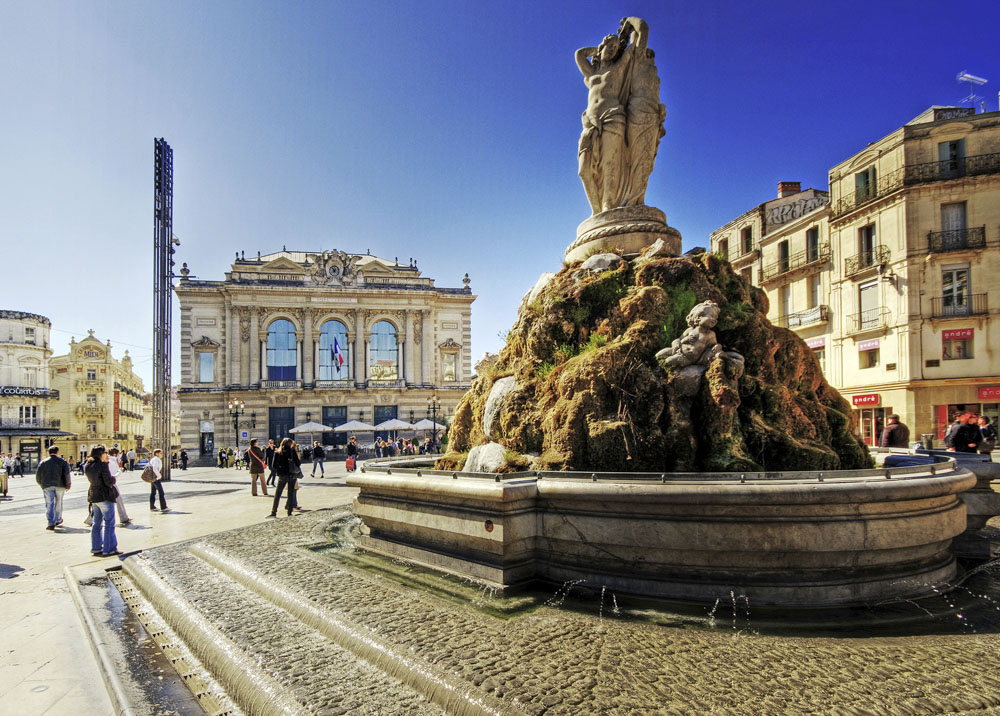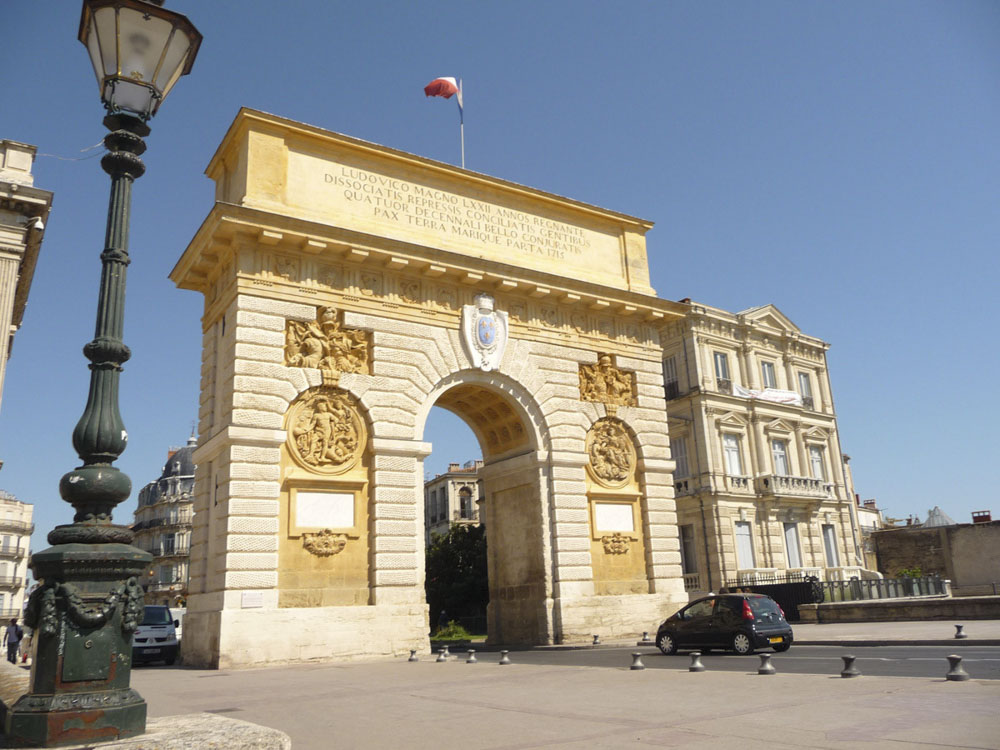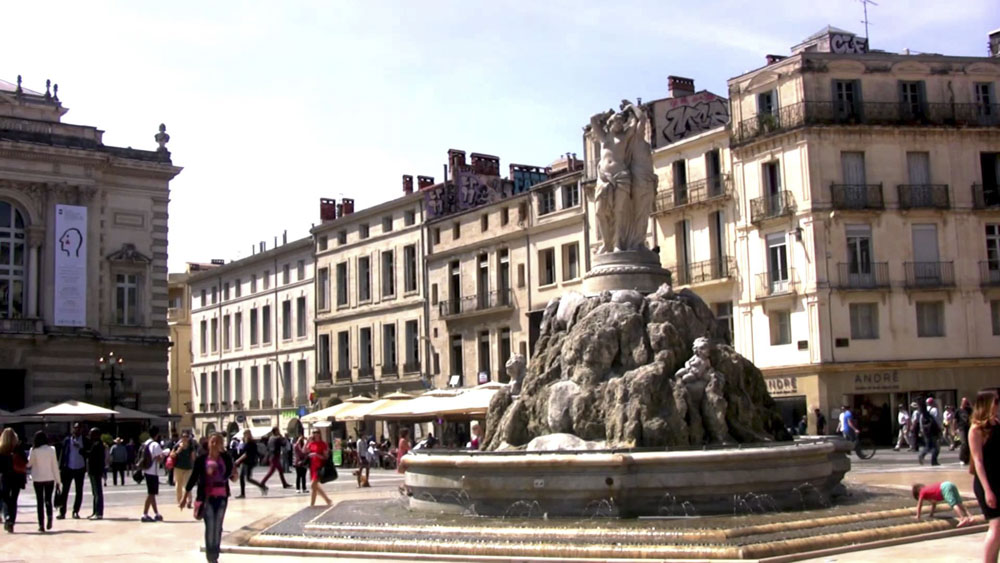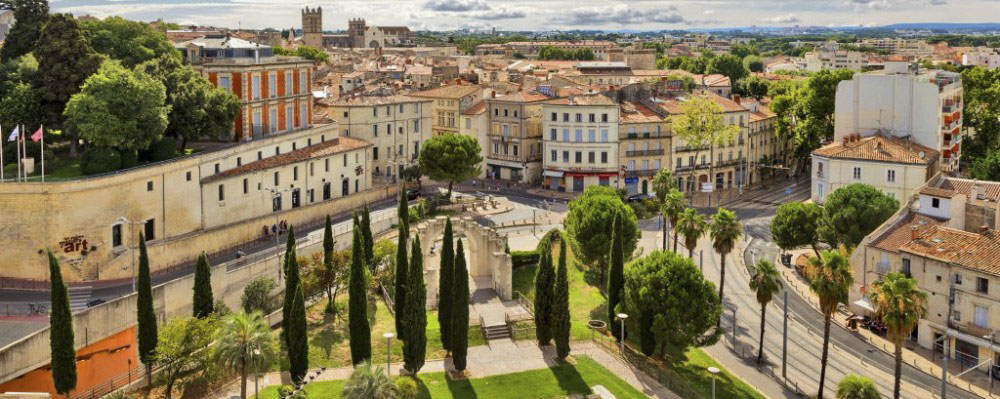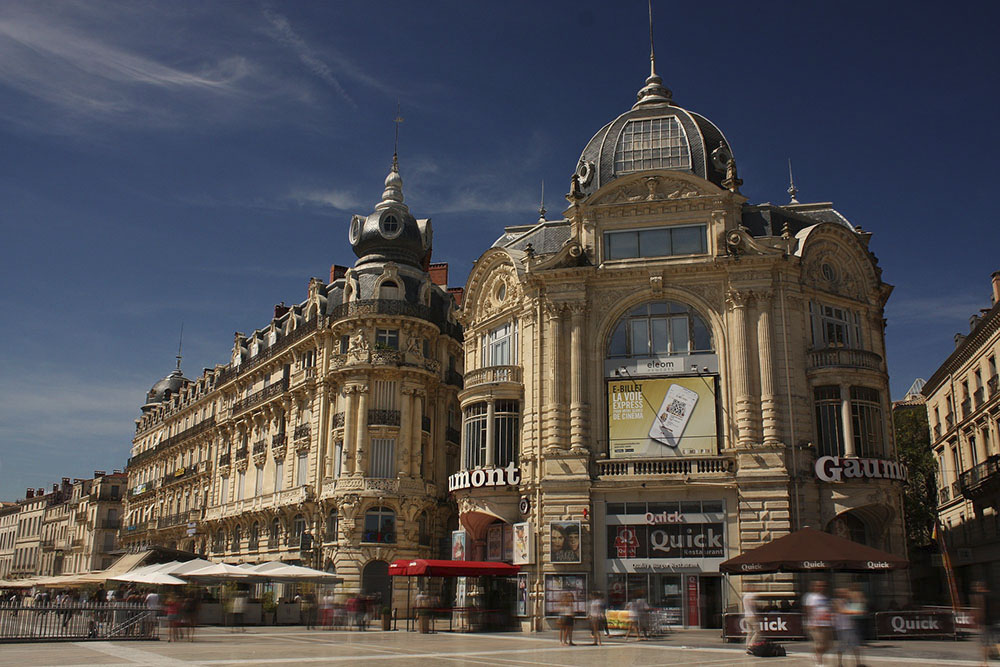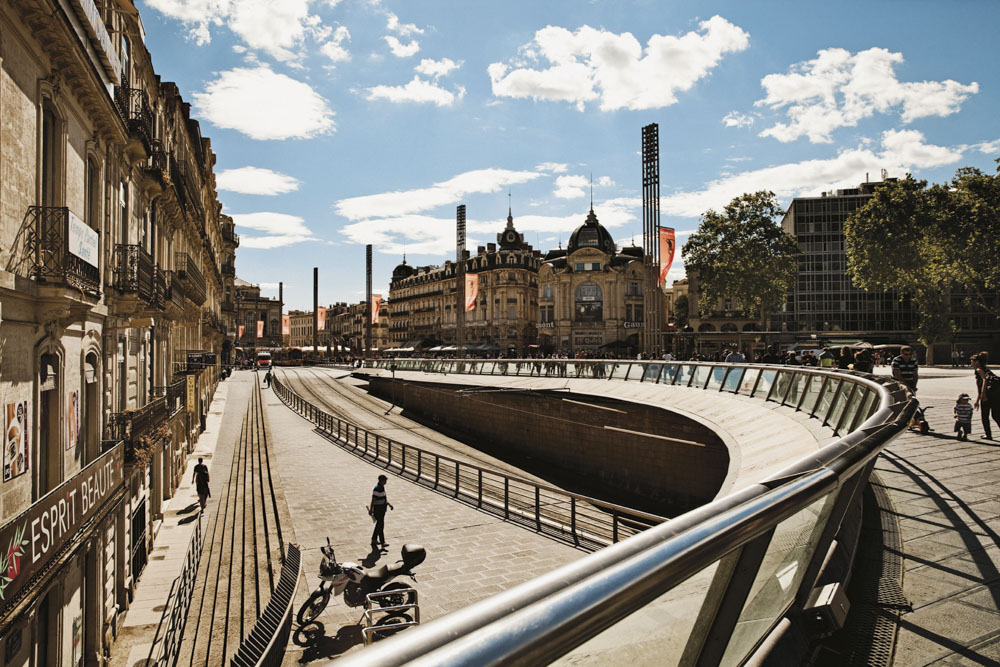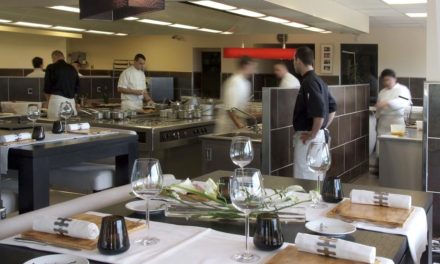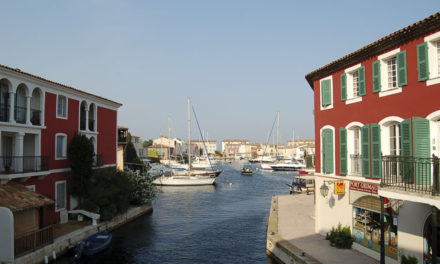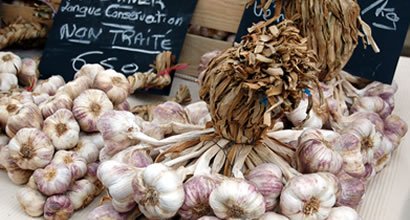Montpellier is the capital of the Languedoc-Roussillon region in the Hérault department, southern France. Located on the Mediterranean coast on the River Lez, it is the fastest growing city in France with a population of 260,000 (a quarter of its citizens are students). Its rich heritage and vibrant atmosphere make Montpellier an ideal holiday destination as well as an increasingly popular business centre. Only 11 kms from the Mediterranean sea and less than 3 hours from Barcelona and Italy, it offers visitors a fascinating medieval city to explore and ranks among the most prestigious world heritage sites. Montpellier has a long university tradition with nearly 70,000 students living in the area. With this youthful influence there is an abundance of festivals, cafés, bars and restaurants where having fun is just part of the agenda!
Book a Hotel in Montpellier
History
Montpellier was gifted to the Guilhem family in the 10th century who settled and ruled the city for the next 200 years. During the 13th century, Montpellier became a very important trading centre between the Mediterranean, northern Europe and Spain with a rich Jewish cultural life and a tradition of tolerance with Muslims, Jews, Cathars and Protestants. A school of law and a faculty for medicine were established and in 1289 Pope Nicholas IV granted the schools University status.
In 1349 Montpellier was sold to the Kingdom of France as one of the most important cities in France. It became prosperous for its trade in spices, sugar and silk and also ‘cochineal’ – a red dye derived from insects living on native oak trees. However, a plague which killed many of the inhabitants wreaked havoc with the prosperity of the region and it wasn’t until the 1400s that the city recovered both population-wise and economically.
The War of Religions which waged throughout the area in the 16th century impacted on the city’s architecture with the destruction of nearly all of its medieval buildings. However, during the next two centuries, many of these architectural achievements were remodelled and renovated. Theological institutions led to many interesting churches being re-built and the study of religions became a faculty of the university. During the 17th century Montpellier became the royal capital of Languedoc. In the 19th century the introduction of wine making to the area helped to build the economy and provide local citizens with larger incomes.
During the 19th century, the city developed into an industrial centre and the population grew dramatically, particularly with the influx of French settlers from Algeria. In the 1980s and 1990s, the city saw a number of major redevelopment projects including the modern concert halls of Le Corum and the Antigone District. Designed by world renowned architects, Montpellier is a unique example of intelligent city planning in Europe which is also rich with 1,000 years of history.
Attractions
The city is divided into seven official neighbourhoods:
Montpellier-centre : historical centre; Croix-d’Argent; Les Cévennes; Mosson; Hôpitaux-Facultés; Port-Marianne; Prés d’Arenes.
Wandering throughout the historic district you will find over 70 fascinating interior courtyards in private mansions dating from the 16th to 20th centuries. The narrow medieval streets of L’Ecusson are part of the ancient and most attractive part of town with plenty of places to ‘people watch’ from the Place Marché Aux Fleurs and the Place Chabaneau. The Place Jean-Jaures is a square with cafés and bars frequented by students – perfect for an aperitif ! Le Café de la Mer is a long-established Montpellier bar and Esprit Vin is the young professionals’ favourite haunt. There are now a plethora of wine bars throughout the city, the best of which are Le Comptoir (rue du Puits-du-Temple), Mi Barrio (rue du Plan d’Agde) and the Times Café (rue des Tessiers) all with excellent wine lists and good food. The Place de la Comédie is an enticing downtown area for those who enjoy shopping. In the middle of the square is the statue of the Three Graces, Montpellier’s emblematic goddesses. Full of colourful street theatre with people bustling about – from Rue de la Loge, along Grand Rue Jean Moulin to the Ancien Courrier quarter, there are international high street names and chic boutiques in many of the old buildings and plenty of places to relax.
The Triumphal Arch, designed by the architect François d’Orbay, was built on the site of one of the gates of the city’s old ramparts. Montpellier was surrounded by ramparts forming the ‘Commune Cloture’ designated by 25 square towers, however there are only two surviving towers, the Tour des Pins and the Tour de la Babotte which were built around 1200. The surrounding boulevards were later constructed upon the old city’s moats.
Contemporary culture is everywhere ! Every summer the city plays host to dance, music and theatre festivals. Classical music, ballet and opera are regularly featured at the Corum and Comédie concert halls during the Festival de Radio France et Montpellier. Not forgetting the younger audience, there are plenty of opportunities to hear jazz and music of every denomination in two big concert arenas: Le Zenith Sud and L’Arena.
Montpellier does not have a modern art museum but the recently renovated Musée Fabre has a vast collection of 17th, 18th, 19th and 20th century works from Flanders, France and Italy. Entering via the inner court of the former Jesuit college, it is one of the biggest and best museums in France and includes ceramics and sculptures. La Panacée hosts temporary exhibitions of contemporary art and it is well worth a visit to appreciate the characterful buildings and courtyard. The Sainte Anne neighbourhood is also home to the International Music Academy of Montpellier which promotes and teaches musical culture. The city is the violin-making capital and many workshops have been created to house fine instrument-makers and artisans.
La Place Royale du Peyrou esplanade, known as the Royal Square, with its panoramic view, towering statue of Louis XIV, Arc de Triomphe, water tower and the ancient arches of a Roman aqueduct, was built in 1774 to celebrate the King’s accession to the throne. Saint-Pierre Cathedral was commissioned by Pope Urbain V in 1364 but was not completed until 1536. It is known for its two rocket-shaped pillars which support a stone canopy above the main door.
The Faculté de Médecine is located in the ancient halls of a medieval monastery and Episcopal Palace which is open to the public. Tours can be arranged through the Tourist Office. This is the oldest college of medicine in France and the anatomy museum (Le Musée d’Anatomie) shows the realities of teaching throughout different periods of history. The great lecture hall, the Henri IV building, the anatomy building and the Institute of Biology were built in the 19th century.
The Botanical Garden (Les Jardin des Plantes), created by Henri IV in 1593 is now part of a landscaped park and arboretum in the grounds of the University of Montpellier and is classified as a Historical Monument and Protected Site.
The Medieval Mikve is a ceremonial bath dating from the 13th century which is a reminder of the importance of the Jewish community which played a vital part in the development and influence of Montpellier.
Accommodation & Restaurants
With two Michelin stars, contemporary décor and a huge glass-walled dining room, Le Jardin des Sens is the place to spoil yourself in Montpellier. The hotel is decorated with art and sculptures and the rooms overlook the outdoor swimming pool and garden. The restaurant serves gastronomic Mediterranean cuisine and guests can dine on the terrace.
Les Vignes (rue Bonnier d’Alco) serves excellent Provencal food and Prouhèze Saveur (avenue de la Pompiginan) is a welcome treat offering a bistro-type environment with an old-fashioned zinc bar and a cosy fireplace or seating for 70 outside on the patio. La Reserve Rimbaud is set in an old building surrounded by greenery and a sunny terrace over the River Lez. Le Ban des Gourmands, Le Castel Ronceray, La Diligence and La Maison de la Lozère are all favourites.
Montpellier is very cosmopolitan and has a wide variety of ethnic cuisines available in addition to traditional French food. Classic French cafés and bistros are good value and several are found near La Place de la Comédie. Unsurprisingly with such a student population, there are plenty of bars and a very energetic nightlife !
The Pullman Montpellier Antigone hotel is located in the heart of the historic centre and has a heated outdoor pool on its rooftop terrace. Its Le Vertigo restaurant serves traditional cuisine and guests can choose to eat in the dining room or enjoy the panoramic view from the terrace. In the pretty neighbourhood of Place de la Canourgue, surrounded by cafés and antique shops, the 3 star Hotel Guilhem (rue Jean Jacques Rousseau) has 34 rooms in a 16th century building with a leafy garden.
Accommodation to suit every taste and pocket is readily available in Montpellier. From luxury hotels with first class restaurants, modern comfort hotels with business facilities, family run b & b’s, apartment rentals, and reasonably priced no-frills rooms, it’s all here !
Transport
By Air: Montpellier Méditerranée Airport (formerly Fréjorgues). Situated on the outskirts of the city, there is a bus service called Navette which takes you to the centre. There are direct flights from Pairs, Brussels, Frankfurt and London.
By Train: Montpellier St. Roch train station is serviced by TGV from Paris . Most destinations in Southern France are easily accessible from Montpellier.
By Car: From the A9 motorway, take any of the 5 exits that service Montpellier. The A75 is free of charge between Clermont-Ferrand and Montpellier.
By Boat: The nearest sea port, situated in Sète, has ferry crossings to the Balearic Islands, Mahgreb and Corsica.

